
Falling Raindrops, by Bob Story
Ken Duquaine
Sometimes the speed of photographic technological development makes my head spin. At the same time, the utility of that development from the standpoint of the average photographer often is questionable. Following are a couple of recent examples.
Some Canon models—the EOS R as an example—are now offering a new shooting mode called FV, which stands for Flexible-Priority AE. Some Canon users are understandably uncertain about the use of this mode. In short, it’s a combination of the traditional shooting modes such as Manual, Aperture-priority, and Shutter-priority. In FV mode the user can set the shutter speed, aperture, and ISO value manually or automatically and, if required, apply exposure compensation. When done automatically, it is very similar to the Program mode, which has been available on cameras forever. In reality, it’s equivalent to shooting in Manual +Auto ISO+Exposure compensation, which has also been available for some time on Canon cameras. The main difference is that FV mode offers the ability to toggle between shutter speed, aperture, exposure compensation, and ISO, using the thumb dial with a top dial that allows adjustment to whichever exposure variable one wishes. The bottom line is that FV allows the user to quickly switch from Auto to Manual or between the different exposure modes without having to turn the mode dial to a different shooting mode.
Another rather mind-boggling offer is Sony’s new a9 III, which incorporates Global Shutter, Pre-Capture, and a jaw-dropping top rate of 120 frames per second in a full-frame mirrorless camera. Equally jaw-dropping is the price, weighing in at $5,998 (body only) for its February release. Global Shutter solves a number of capture problems encountered by rolling shutters, such as skew and other artifacts, as well as allowing flash sync speeds up to 1/80,000 of a second. It eliminates the mechanical shutter entirely. Pre-capture can be configured to begin recording images to the buffer when the shutter button is half-pressed. Those images will be saved when the shutter is fully pressed.
While I’m sure that these features will be useful to some professional wildlife and sports photographers, their utility in the hands of most of us—even those of us who could afford them—is open to question.
The Sun Lakes Camera Club’s (SLCC) next general meeting will be on Thursday, Jan. 11. Our speaker will be Robert Gallucci, an award-winning photographer, one of whose specialties is photographing storms and unusual weather.
The Sun Lakes Camera Club meets on the second and fourth Thursdays from 6:30 to 8:30 p.m., in the Lecture Hall of the Cottonwood Country Club from October through April. For more information about the SLCC and its activities, contact SLCC President Samantha (Sam) Palmatier at 907-727-0334 or [email protected] or past President Lynn Thompson at 480-734-0040 or [email protected], and visit our website, www.sunlakescameraclub.com.
